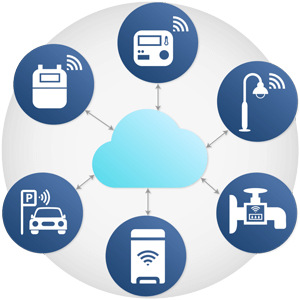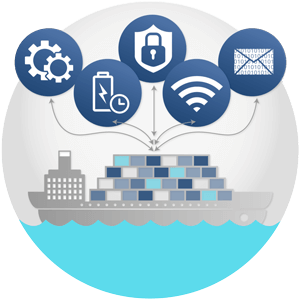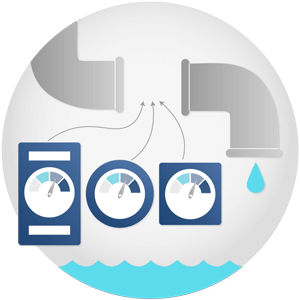The LwM2M Protocol
The LwM2M Protocol
Lightweight Machine to Machine, or LwM2M, is a device management protocol developed by OMA SpecWorks to address the needs of low-power and low-bandwidth IoT devices. Known best for its efficiency, it is ideal in constrained environments where traditional connectivity is not available. For example, a smart water meter can be difficult and expensive to reach. LwM2M allows the smart water meter to connect directly to the internet, while not requiring much bandwidth or processing power from the device. This unmatched capability allows smart meters to have a lifespan of up to 20 years. And while LwM2M is the best choice for constrained devices, it is also an excellent connectivity solution for any IoT device, thanks to its numerous applications in device management.
Common Questions About LwM2M
IoT Device Management is the ability to remotely monitor, control, configure, and update your IoT device throughout its lifecycle. This includes the option to remotely:
- commission and decommission a device
- update the device’s firmware (FOTA)
- obtain data from the device
- install or update security on the device
- and much more
These features allow organisations to reduce their budgets for in-person visits to sites that are often difficult and expensive to access. Furthermore, they are a significant evolution in efficiency and security for organisations that are tasked with manually logging into each individual device through a command line terminal to make updates and changes.
When Numbers Matter
IoT device management is useful for organisations managing 10 devices, but it becomes a necessity when there are 100 or 1,000,000. Sending someone to physically take a reading of the device or install an update is not feasible with a fleet of devices. And as the number of IoT devices being purchased and installed around the world is growing at a rapid pace, the demand for controlling and monitoring devices within one system is also increasing. Organisations that install IoT devices are looking for simplicity and automation, and device management is the key to this.
Why is interoperability important? Let’s use an example of a Smart City that is installing 1,000 smart street lights. The streetlights are able to sense weather conditions, traffic patterns, and the amount of sunlight emitted in order to react accordingly. This small adaptation saves the city millions of euros in electricity costs over a 2 year period.
The city has now seen the potential of what IoT can offer, and wants to install smart garbage cans and smart parking meters. Setting up three separate systems for the city’s lights, garbage cans, and parking meters is not reasonable, especially if the city would like to invest in smart buildings later on. The ideal scenario is one where the city is able to control and update its smart lights, garbage cans, and parking meters within one system, requiring all of these devices to communicate through a common language that the device management system understands. LwM2M provides this for both devices (the client) and the device management system (the server), meaning that the devices and device management system can communicate back and forth.
Why are open standards important?
Let’s take the example of a Smart City again. The smart city has seen the advantages that IoT technology can offer, and wants to install smart street lights, smart garbage cans, and smart parking meters. Technologies built on open standards, such as LwM2M, allow the city to buy devices from multiple LwM2M manufacturers, rather than from one manufacturer that has created their own proprietary device management technology. This means that the Smart City is free to choose its smart streetlights and smart garbage collectors from one manufacturer, but to purchase its smart parking meters from another who offers more suitable features.
LwM2M is used by both industries and device manufacturers. Industries where LwM2M has been widely adopted include:
- Utilities
- Smart cities
- Tracking and logistics
- Agriculture
- Healthcare
- Consumer electronics
Numerous LwM2M devices have been created to support these sectors, from constrained devices to ones with incredible power. A few examples include: smart meters, smart street lights, smart trackers, fertilisation sensors, and emergency and critical devices. Ultimately, LwM2M is applicable for any IoT device that needs to be controlled, tracked, or managed.
Many companies investigating LwM2M eventually ask the question: “Is LwM2M or MQTT better?” Although much can be said on this subject, a very brief summary is that device management needs a language to install, update, and maintain IoT devices. LwM2M is one of these languages. Conversely, MQTT is simply a phone that lets you call someone. LwM2M can use a CoAP phone, an MQTT phone or an HTTP phone.
To speak more technically, choosing an IoT protocol for device management means choosing a protocol that offers a comprehensive set of features. MQTT has some of these: it is a reliable transportation method for messages, and may be a great choice for organisations who are looking to publish a large amount of data from the device to the cloud. However, it is not possible to define the semantic of these messages with MQTT, making device management and interoperability impossible.
Since we work with a number of companies who use IoT integrations on very large-scale wireless cloud LANs, like utilities companies or smart city management companies, we typically recommend LwM2M because it requires a low amount of power and bandwidth. LwM2M also works when a network is unreliable, and doesn’t require too many handshakes for messages sent over the network. These features are deeply appreciated by our clients, since devices are often numerous and physically challenging to access and update.
LwM2M & MQTT: Not always an either/or scenario
Although LwM2M is more comprehensive, some organisations have already adopted MQTT for data reporting a number of years ago. They would like to take advantage of LwM2M, but changing their entire system is difficult and costly. The good news is that LwM2M can be used on top of MQTT. Organisations in these scenarios often combine LwM2M to meet their device management needs, and continue to use MQTT for their data reporting.
Much more can be said on this subject, and we’d be happy to discuss the subject in length. You can contact us at the bottom of the page.
Advantages of Using LwM2M




